Kashi or Varanasi has been known as the city as old as time, a place of massive spirituality and a godly presence that can be felt in almost all the corners of the city – be it the galis, gardens or the Ghats of Varanasi.
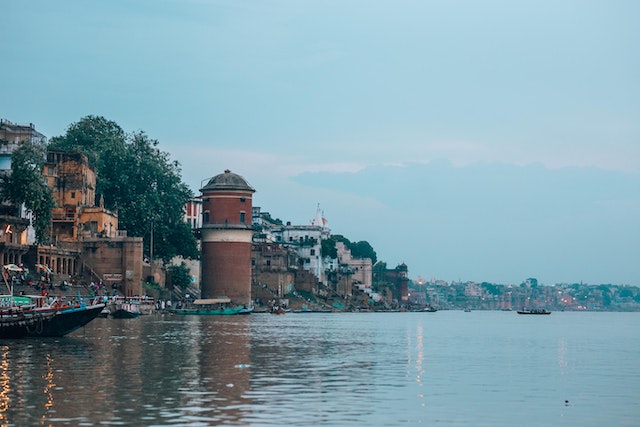
With the larger than life rituals, the presence of so many people and devotees from all around the world and the essence of Lord Shiva & Maa Parvati, Varanasi needs to be a place that you have to visit at least once in life – wherever you are.
In this blog, we have previously talked about the Punctuation of Life in Varanasi and my first experience of exploring the city as old as time.
With the third article on Varanasi, we embark on a journey to explore the most fascinating Ghats of Varanasi, delving into their history, spirituality, and the vibrant tapestry of rituals and traditions that unfold along the riverfront.
Let’s Go!
Table of Contents
Important Ghats in Varanasi
First of all let us start with the most famous or important ghats in Varanasi. These include the most popular Ghats that one must have heard of even though you haven’t yet visited Kashi.
Dashashwamedh Ghat
The Dashashwamedh Ghat is the most popular one among the Ghats of Varanasi and is a prime spot for devotees as they witness one of the most magical events in the world – the Ganga Aarti.

As the flames flicker, the chants form a rhythmic pattern and the people all gather around near the Holy Ganges – it becomes a moment where everyone is present, all at once, feeling the presence of Shiva all around them.
Dashashwamedh can be broken down further to understand the origin behind it’s name : Dash meaning 10, Ashwa meaning Horses.
It is believed that Lord Brahma himself performed a 10 horses’ sacrifice ritual (Ashwamedh Yagya) over here at the Dashashwamedh Ghat to welcome Lord Shiva.
Manikarnika Ghat
Another really infamous among the many Ghats of Varanasi is the Manikarnika Ghat. It is the one where the “flame never fades“.

As per the legend goes, once when Lord Shiva and Parvati came here to bathe in the holy river of Ganga, the Mani (beads) from Shiva’s ear and the Karnam-Angad (ear ornament) of Maa Parvati, both fell into the river.
After failing to find the ornaments after searching for long, Shiva couldn’t control his anger and cursed the place with an everlasting burning flame!
Many other gods came down to request Shiva to take his curse back, but he couldn’t. So he blessed this place to become a spot wherein if any human is cremated, his or her soul will attain moksha and journey towards Heaven.
Now, when you visit this place, you will always see a flame burning right in the middle of the Manikarnika Ghat. It is said that bodies from all around India keep coming to the place for cremation and the ceremony keeps going on day and night over here.
Assi Ghat
Situated at the confluence of the holy rivers Ganges and Assi, the Assi Ghat has an incredible spiritual significance as well.

It is said that after slaying the Demon Shumbha, Shiva threw his sword straight into the river – forming the Assi Ghat.
The best time to visit this Ghat in Varanasi is during the sunrise. People tend to start their Varanasi journey after witnessing the sunrise boat ride towards the other side of the Assi Ghat and then bathing into the Ganga River.
Other than being a site of religious significance, the Assi Ghat in Varanasi also is a vibrant cultural hub. It acts as a popular meeting point for yogis, scholars and artists looking for peace and serenity for their work.
You can find a large space where more than 50 people sit down in the morning after sunrise, to perform yoga.
Many engage in discussions about ancient texts, scriptures and enjoy the captivating musical performances that take place here.
Namo Ghat
A fascinating, picturesque and insta-worthy Ghat of Varanasi that recently gained a lot of visitors is called the Namo Ghat.

Namo means to “pay homage” or “to bow down” as a respect. The Namo Ghat is a revered spot for pilgrims along with the devotees who come here to perform rituals and immerse themselves in the evening ceremonies and prayers.
The steps that lead to the river are adorned with intricate carvings and sculptures of folded hands in the form of Namaste – showcasing the Indian cultural heritage.
The ghat also provides a serene and picturesque setting for tourists to witness the vibrant rituals, mesmerizing Aarti ceremonies, and the timeless flow of life along the sacred river. Namo Ghat serves as a timeless symbol of faith, devotion, and the eternal spiritual essence of Varanasi.
Darbhanga Ghat
This one stands out to be one of the most insta-worthy or photogenic Ghats of Varanasi. With the visually appealing architecture and the luxurious Brijrama Palace hotel at the background, the photographers would have a marvelous time here.

Before turning the Palace into a hotel, it was a fort built by Shridhar Narayan Munshi, the minister of the Nagpur estate.
Later on, in 1915, King Rameshwar Singh Bahadur acquired the fort and turned it into a massive palace.
Now, an Indian Hospitality Company owns the property and turned it into a Palace Hotel.
Munshi Ghat
क्रोध में मनुष्य अपने विचारों के बारे में नहीं बोलता, वो बस दूसरो का दिल दुखाना चाहता है..!
Munshi Premchand
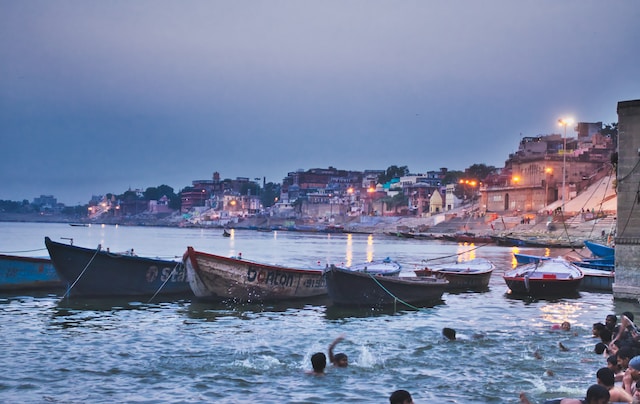
Y’all might have heard the name even if you don’t know his work – Munshi Premchand. He was a legendary Hindi Writer known for his writing style that captivated readers into the story like no other could.
The Munshi Ghat, as the name suggests is dedicated to the literary pioneer and one can find many artists, writers, etc. sitting near the Ghat, maybe to find some meaning to their life or ideas for their work. Or maybe just to feel what Premchand must be like, must feel like when he wrote the masterpieces that he did.
Also, some consider the theory that the Munshi Ghat is actually named after Shridhar Narayan Munshi.
Other Fascinating Ghats of Varanasi
Harishchandra Ghat
The Harishchandra Ghat is another cremation ground with a belief that the bodies cremated here will attain salvation.

It is one of the oldest and most significant ghats of Varanasi and is named after the King Harishchandra, who contributed towards the perseverance of truth and charity.
Hindus from all around the world come here with dead bodies of their family members and near ones for cremation.
Chet Singh Ghat
Another Ghat with a royal significance in Varanasi, the Chet Singh Ghat was the site of the battle between Maharaja Chet Singh and the British, back in the 18th Century.

Chet Singh ruled Varanasi and constructed a fort near the Ghat. But after the battle, the British one and imprisoned the king inside his own fort. A legend goes that Chet Singh later escaped using a rope made of turbans.
Man Mandir Ghat
Man Mandir Ghat is one of the oldest ghats of Varanasi and it’s notable Rajputana architecture makes it a popular spot in Kashi to be visited by many explorers.

Another attraction of the Ghat is the palace constructed by Raja Man Singh of Jaipur in 1600, wherein an additional observatory was then built by Sawai Jai Singh II in 1730s.
People head up to the spacious terrace of the observatory to glimpse the fascinating sight of the open sky and the mystical Ganges.
Scindia Ghat
Another photogenic spot in the list of Ghats in Varanasi is the Scindia Ghat.
It is known as the most peaceful ghat, even though it is situated close to the grimly Manikarnika or Burning Ghat.

As you explore the ghats of Varanasi on a boat, you can see a submerged Shiva temple near the water’s edge. It is believed to be sunk during the construction of this ghat in 1830.
Another story of the sunken Shiva temple that the boat person will tell you is related to a son and a mother.
It is said that many years ago, a mother was a big believer of Shiva and used to come visit the Kashi temple whenever she wanted to. As she grew older, she couldn’t move as much as she would like.
So she asked her son to build a temple near the ghats of Ganga where she could sit and spend her remaining days in the devotion of Shiva.
Her son constructed the Shiva temple and brought his mother to witness it. Later, he told his mother that now that I have fulfilled your wish of a Shiva temple, can you rid me of your milk’s karz (loan). Hearing this, his mother was shattered and cursed the temple to never be worshipped as a loan of mother’s milk can never be paid.
Thus, the temple got submerged in the Ganges, and no one could ever get to really worship in the place.
Panchganga Ghat
The Panchganga Ghat is situated at the far northern end of the Varanasi Ghats. It got this name due to the merging of five rivers (Ganges, Yamuna, Saraswati, Kinara and Dhutpapa).
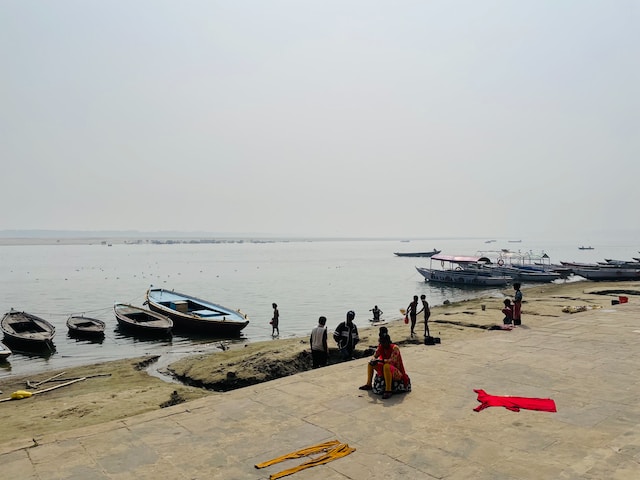
Not many people visit this particular Ghat, but the ones that do will tell you it is one among the most serene spots to ever exist in the spiritual land of Kashi.
You can find a 17th century Alamgir Mosque built right above the Ghat. This structure was built by the Mughal ruler Aurangzeb during his reign when he destroyed a Vishnu Temple.
The best time to visit the Panchganga Ghat is just before Dev Deepavali, when the entire ghat is filled with light decorations with candle-filled baskets hanging from poles to honor ancestors.
Ganga Mahal Ghat
Varanasi, being the oldest city, has seen many rulers change. The Narayan Dynasty ruled over the city up until the 20th Century AD.

In 1830, Maharaja of Banaras constructed the grand palace over the banks of the Ganga River and named it as “Ganga Mahal” – thus, giving the ghat it’s name and an incredible attraction.
The Ghat is just near the Assi Ghat, only separated by a few stone steps.
The Rajputana architecture, culture and grandeur can be felt and seen as one enters the ghat and explores the Mahal.
Rewa Ghat
Rewa Ghat was donated to BHU in the 20th Century by the King of Rewa to later be designed in the Astha Pahal style of architecture with concrete stairs protecting the Ghat from the strong currents of the Ganges.

Before the King of Rewa got this place, it was known as the Lala Mishir Ghat, named after Maharaja Ranjit Singh of Punjab.
Tulsi Ghat
Named after one of the most celebrated poet and saint Tulsidas, the Tulsi Ghat is a very peaceful ghat in Varanasi.

Also, it is believed to be the spot of the first ever Ramleela as per the Hindu legends.
Another legend goes that when Tulsidas composed the fascinating Hindu epic Ramcharitmanas in Varanasi, his manuscript fell into the Ganga river. But rather than sinking, the script kept floating over the river near the Ghat.
A Lord Ram temple was later built over the spot and many relics of the legendary poet Tulsidas are still preserved over there at the Tulsi Ghat.
Conclusion
The ghats of Varanasi holds a significant space in the hearts of devotees as well as for travellers. The Galiyaans and Ghats are the major part of the Varanasi heritage and an embodiment of the spiritual essence with fascinating history, culture and ceremonies.
Every Ghat in the city has it’s own story. From the Everlasting Flame of the Manikarnika Ghat to the Mesmerizing Ganga Aarti at the Dashashwamedh Ghat and the Picturesque Namo Ghat that’s doing rounds on Instagram – the stories are endless. And so is the vibe of the place.
Comment down below your favorite Ghat of Varanasi and tell everyone why is that so. Share the blog post with your friends and family.
That’s All Folks!



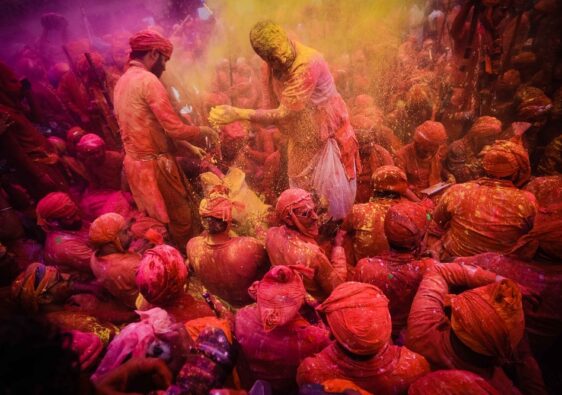
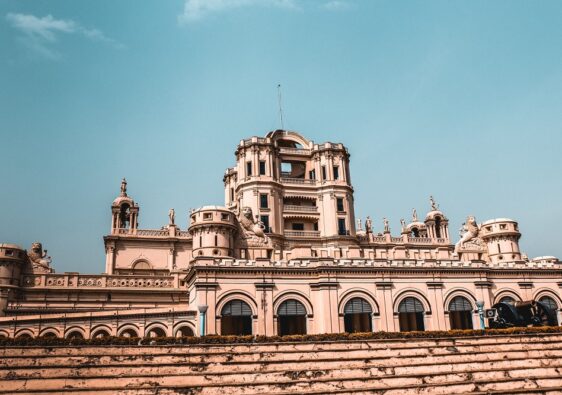
❤️✨️